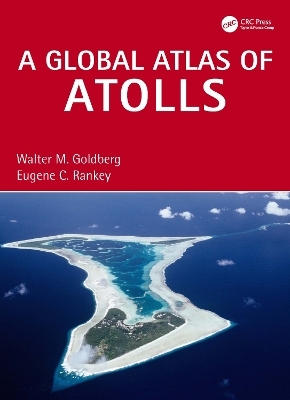
A Global Atlas of Atolls
CRC Press (Verlag)
978-1-032-26246-8 (ISBN)
Scattered like dots rising from the deep across vast expanses of the world’s tropical and subtropical oceans, atolls with their turquoise lagoons and reefs teeming with colorful marine life have captured the public imagination. They have also been the homeland of millions of people for millennia as various groups of migrants spread across the far reaches if the Pacific, Indian and Western Atlantic regions. Developed from recently available satellite data, A Global Atlas of Atolls presents high-quality details of 476 atolls across the globe, characterizing aspects of the atoll rim, the lagoon, and their coral reef communities in unprecedented detail. In synthesizing and enhancing understanding of these unique seascapes, this volume provides a distinct compendium of descriptions and images, as well as documentation of the environmental conditions of winds, waves, and tides and a summary of the background literature for each atoll area. There is no comparable work.
After an introduction that includes a glossary of terms, each atoll is documented in the form of an atlas written for scientists, but accessible to any diver or reader interested in these spectacular reef-island habitats. This book also describes some current challenges and perspectives on their future. It will be useful as a reference work for marine scientists, while providing a minimum of technical jargon for those who are not scientists, but who enjoy reading about exotic places with unusual attributes.
Walter M. Goldberg graduated from the American University, Washington DC with a Batchelor of Science degree and was awarded a Ph.D. in Biological Oceanography by the University of Miami’s School of Marine and Atmospheric Sciences. He is currently Professor Emeritus at Florida International University in Miami where he was a faculty member for 40 years and the youngest in the Department of Biological Sciences to begin his career there at the age of 27. While on the faculty he taught a variety of courses ranging from Electron Microscopy for graduate students to Marine Science for non-majors. In addition to teaching and research, Walter served as department chair at a time when Biological Sciences at FIU was half the size it is now. He is the author of more than 50 professional papers, mostly on the formation, structure, and biochemistry of coral skeletons. After retirement, he taught Scientific Writing at FIU for an additional decade. He now lives in Stuart, FL with his wife Rosalie whom he met when she was a freshman at AU. They have two boys and two granddaughters. Walter has always been involved in sports. At AU he was captain of the wrestling team and was conference champion at 123 lbs. He played racquetball and squash for 25 years and now is an avid pickleball player. His nom du sport is Walt, not Walter. Eugene C. Rankey is Professor of Geology at the University of Kansas, where he has taught since 2008. A geologist by formal training, Gene’s research program focuses on understanding geological, chemical, physical, and biological aspects of the oceans, how they shape the seascapes of tropical marine and coastal systems, and expression of comparable processes in the ancient rock record. In addition to remote-sensing analyses from around the globe, field efforts have ranged from the South Pacific (including in the Cook Islands, French Polynesia, and Kiribati), Southeast Asia, and the Caribbean, and included numerical modeling of dynamics of shoreline and atoll systems. Gene graduated with a B.S. degree from Augustana College (IL), a M.S. from University of Tennessee, and a Ph.D. from University of Kansas; he worked at Exxon Production Research Company, Iowa State University, and the Rosenstiel School of Marine and Atmospheric Sciences at the University of Miami before returning to Kansas. He has written more than 60 nerdy scientific papers, edited several volumes, and served as editor and/or associate editor for five journals. He lives in Paola, Kansas, near the geographic center of the U.S., and far from the ocean, where he claims to be a soccer (football) star in the city’s adult league, straightens headstones in the church cemetery, and lifts modest weights. His four kids are grown and scattered across the globe, but his dogs miss him when he travels to see his island friends.
Introduction. Materials and Methods. Polynesia and the Tuamotu Archipelago. The Society Islands. The Cook Islands. South Central Pacific (Swains, Rose, Beveridge). Tokelau Islands. Tuvalu. Kiribati (Line, Phoenix, Gilbert Islands). Hawaii and the Central Pacific Atolls of the USA. Micronesia and the Marshall Islands. Micronesia and The Caroline Islands. Melanesia, New Guinea and the Coral Sea. The Solomon Islands. Fiji. The Coral Sea. North West Australia. Indonesia. South China and the Sulu Sea. Central Indian Ocean (Lakshadweep, Maldive and Chagos Archipelagos). Western Indian Ocean. Western Atlantic Ocean . Summary and Atolls of the 21st century.
| Erscheinungsdatum | 31.08.2023 |
|---|---|
| Zusatzinfo | 3 Tables, color; 10 Line drawings, color; 256 Halftones, color; 266 Illustrations, color |
| Verlagsort | London |
| Sprache | englisch |
| Maße | 210 x 280 mm |
| Gewicht | 1600 g |
| Themenwelt | Naturwissenschaften ► Biologie ► Botanik |
| Naturwissenschaften ► Biologie ► Limnologie / Meeresbiologie | |
| Naturwissenschaften ► Biologie ► Ökologie / Naturschutz | |
| Naturwissenschaften ► Geowissenschaften ► Hydrologie / Ozeanografie | |
| Weitere Fachgebiete ► Land- / Forstwirtschaft / Fischerei | |
| ISBN-10 | 1-032-26246-X / 103226246X |
| ISBN-13 | 978-1-032-26246-8 / 9781032262468 |
| Zustand | Neuware |
| Informationen gemäß Produktsicherheitsverordnung (GPSR) | |
| Haben Sie eine Frage zum Produkt? |
aus dem Bereich


